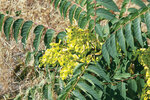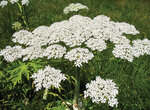


As fall weather brings frequent showers to Battle Ground, landowners will once again fight the growth of hazardous noxious weeds. These plants are an increasing threat that can damage the environment and harm people and animals. Identifying, safely removing and preventing these dangerous weeds from taking root can be difficult.
Fortunately, the Clark County Master Gardener Program and Clark County Noxious Weed Control Board offer resources to identify, report and remove noxious weeds before they become a large-scale threat.
Every state and county has a different list of noxious weeds, according to Erika Johnson, master gardener coordinator for the Washington State University Clark County Master Gardener Program.
“Noxious weeds are defined as non-native plants that can be toxic, destructive, competitive and particularly difficult to control once established,” Johnson said in an email.
Noxious weeds are known to cause an immense detrimental economic impact, especially on agriculture.
“Noxious weeds cost the United States on average $30.6 billion each year in decreased land value, money and time spent on control efforts, lower crop yields, reduced forage quality and impacts on animal health,” Johnson said.
Additionally, noxious weeds can harm the environment, increasing the risk of environmental disaster.
“Noxious weeds displace native species, destroy natural habitats, clog waterways and increase erosion and fire risk,” Johnson said.
These dangerous plants can harm humans and livestock, as well.
“Many noxious weeds are toxic to humans and livestock. Contact or ingestion of some species can lead to serious health problems or even death,” Johnson said.
Differentiating noxious weeds from safe, or even beneficial ones, can be difficult. The Washington State Noxious Weed Board offers a comprehensive website with additional information about dangerous plants. Documentation, including pictures, growth habits and safe removal information is available. An identification tool allows users to search for plants by toxicity, habitat and appearance.
For local weed information, the Clark County Noxious Weed Control Board publishes a yearly noxious weed list. The document lists the common and scientific names of dangerous plants and whether they need to be eradicated or controlled. More information, including the 2023 noxious weed list, can be found at clark.wa.gov.
To prevent an overwhelming infestation of noxious weeds, Johnson encourages landowners to remove weeds early.
“Being aware of the area’s concerning weeds and scouting for them — early and often — are great ways to avoid a new infestation,” Johnson said.
Johnson herself has experienced aggressive noxious weeds in her yard, including lesser celandine.
“I was surprised one day to find one plant in my small suburban backyard, but I discovered it early and was able to pull it out before it reproduced and spread. I’ve not seen it again in several years,” Johnson said.
Safe removal of noxious weeds can be a challenge. According to the Washington State Weed Control Board’s website, the first step is identifying the weed. Depending on the type of plant, hand-pulling, digging, mowing, tilling or tarping and mulching may be needed. Certain weeds may require protective gear for safe removal.
Though the list of local noxious weeds is updated yearly, some plants have been present in Battle Ground for decades.
Giant hogweed is a common noxious weed in Battle Ground, said Justin Collell, coordinator for the Clark County Noxious Weed Control Board. This flowering weed can grow 10 to 20 feet tall and bears purple splotches along its stem. Its broken stems and leaves leak a sap that increases sunlight sensitivity, increasing the risk of sunburn.
Another Battle Ground noxious weed is poison hemlock. This flowering weed grows up to 12 feet tall, bears fern-like leaves and has purple splotched stems. This lethal plant is often consumed by livestock, Collell said.
“When it gets baled up in hay, it loses the bitterness that makes animals avoid it,” he said. “By the time the animal is showing signs of this poisoning it’s usually too late to save the animal.”
Tree-of-heaven, a common invasive plant across Washington, can also be found in Battle Ground. This fast-growing tree grows in crowded thickets and chokes out native species. It is the preferred host of the spotted lanternfly, a pest threatening the trees and vineyards in Washington, Collell said.
The aquatic noxious weed variable-leaf milfoil, poses great risk in Battle Ground, as well. This non-toxic plant has been primarily found in Lake Merwin and can clog bodies of water, shading out native plants and reducing water flow.
“Once it gets going, it can just take over your pond,” Collell said. “We’ve noticed, through DNA testing, that our local infestations — a lot of them — are hybrid, a cross between native milfoil and the invasive variable-leaf milfoil.”
Though the fight against noxious weeds is difficult, planting native species, such as Oregon grape, sword fern, snowberry and salal, can keep invasive plants from growing, he said.
“Native plants can produce competition for resources, like sunlight and water,” Collell said. “ If you, for instance, have a dense thicket of snowberry or salal, those can create a canopy. Noxious weeds won’t get a foothold,” Collell said.
However, newly planted native greenery will need to be guarded.
“The reason why noxious weeds are such a problem is that they out-compete native plants,” Collell said. “You have to guard them or reduce the competition from the invasives around them.”
Clark County Noxious Weed Control Board is available to help identify noxious weeds. Locals are encouraged to share photographs and provide a description and location. Reports can be made at the website, invasivespe cies.wa.gov.
“When people report noxious weeds I get alerts in my email inbox. Then I can immediately see if we have a new species or if it is an extension of an infestation we already have,” Collell said. “It’s especially important to submit photos.”
To get the latest updates on noxious weeds, or learn more about local weeds, visit the Noxious Weed Control Board’s website, nwcb.wa.gov. The Clark County Noxious Weed Control Board can be contacted via email or phone, at weed.management@clark.wa.gov or 564-397-6140.